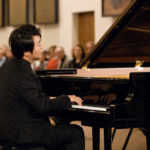We’ve all had some tough nights with Lang Lang. In recent years, Carnegie Hall audiences were treated to a pounded-out Rachmaninoff Piano Concerto No. 1 and a showmanship-overdrive version of Rhapsody in Blue that left no one surprised when he had to take off more time than expected due to a hand injury. But the Goldberg Variations, which he recorded in two different performances released simultaneously on Deutsche Grammophon, occupied a significant part of his life well before he showed that classical artists could achieve rock-star status in China.

To some of his more patient listeners, this is a return to his true self (or at least one of his more neglected true selves). Lang Lang’s exuberant brand of showmanship is genuine. But in concerts he played while emerging from the Curtis Institute, Lang Lang’s calling card was the Mendelssohn Piano Concerto No. 1, in a performance that elegantly underscored the music’s backward-looking classicism. His breakthrough was replacing André Watts at the Ravinia Festival at age 17 in a 1999 fast-and-furious performance of Tchaikovsky’s Piano Concerto No. 1 (first movement), setting the tone for a career that would’ve happened anyway (thanks to carefully-laid groundwork from his Curtis teacher, Gary Graffman).
After the Ravinia performance, he and a few other musicians, including conductor Christoph Eschenbach, stayed up all night as Lang Lang played through his repertoire (much of it from memory), including the Goldberg Variations. So the piece has been in his consciousness, even as he rode more Tchaikovskian repertoire on the road to global domination.
Yet the Goldberg Variations remained, in many ways, the perfect piece for him, with its endlessly varied musical content to keep him deeply interested but enough rigor to keep some of his less-exalted audience-pleasing impulses at bay. In a spectrum of Goldberg recordings with the emotionally dignified 1982 Glenn Gould recording at one end and the brightly colored Daniel Barenboim recording at the other, Lang Lang is close to Barenboim. Of the two Lang Lang versions, I much prefer the studio recording: the kick-ass sensibility that comes out during the live performance at Leipzig’s Thomaskirche has a way of blotting out the precise, cultivated coloristic sensibility — long apparent in his performances of Chinese music — that is the hallmark of the studio recording.
Other key qualities in the studio version: He doesn’t try too hard, but instead lets the music flow seemingly on his own momentum. Rhythms are buoyant. Finger-work is full of cognitive understanding, both structural and expressive. Everything leads somewhere, each passage with its own nuanced character. You don’t sense that he has necessarily worked harder or longer on the Goldberg Variations; he seems to have found a manner of Bach playing that’s organic to him, allowing him to open himself emotionally and unsparingly to wherever Bach might take him — though within a solid conceptual framework. Dramatic contrasts, for example, aren’t about superficial excitement. Evidence abounds of a cultivated overview of the piece — that includes, by the way, taking all of the repeats.
His opening aria is fairly slow, clocking in at 5:12, in contrast the four-to-six minute duration that’s common these days. But if Lang Lang’s slowness is automatically heard as a sign of self-indulgence, one argument in favor of the tempo’s validity could come from Goldberg oracle Glenn Gould. He was considered a bit of a speed demon in his famous 1955 recording, but a live performance from the previous year is as slow as Lang Lang’s, and would be of similar duration had he not skipped the repeats that Lang Lang observes. Lang Lang’s slowness has been problematic in past years, leaving you eavesdropping on a seemingly private experience he was having (such as Schumann’s Träumerei). In Bach’s 25th variation, Lang Lang invites the listener into a true act of musical intimacy.
Elsewhere: The varied coloring in the 11th and 12th variations is an effortless marvel. Ditto for the bass line that springs out of the texture of variation 14. The 15th variation might’ve come out lachrymose in past years; now it’s a tender mixture of melancholy and resignation. At times, you might argue with Lang Lang’s tempo flexibility, though modern, scrupulously authentic harpsichordists such as Céline Frisch breathe with the music similarly. The performance basically belongs to Bach, but it’s animated by the pianist’s considerable musical imagination, now filtered by maturity. This release is easily his finest achievement.

